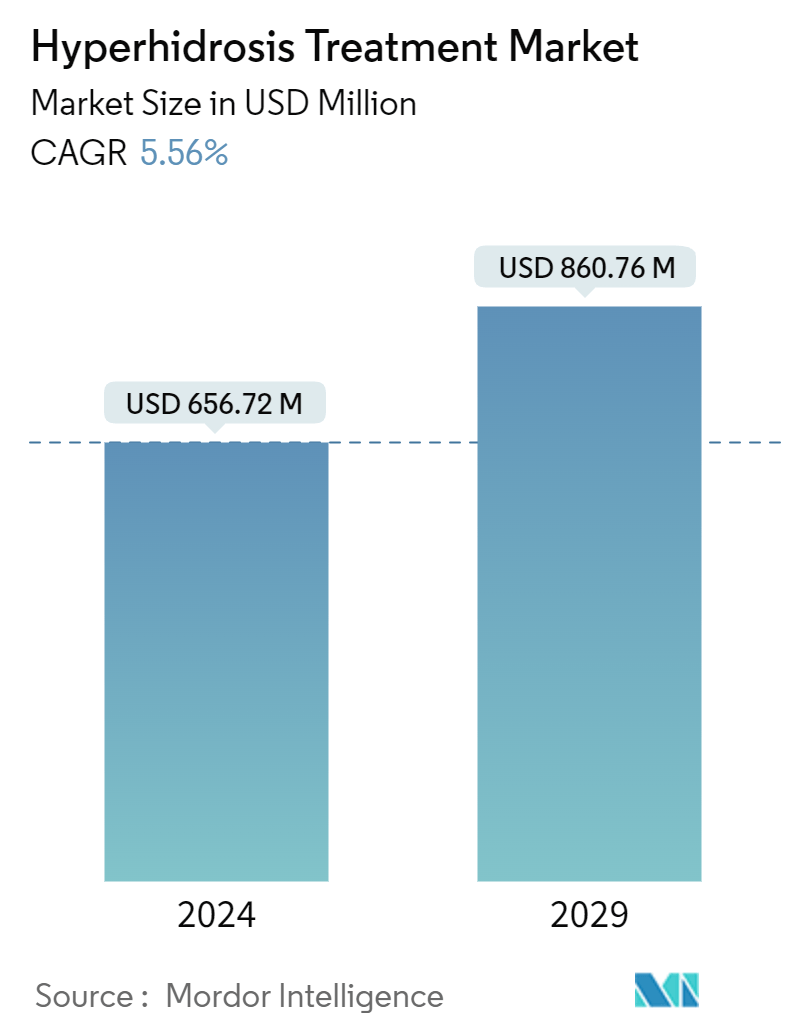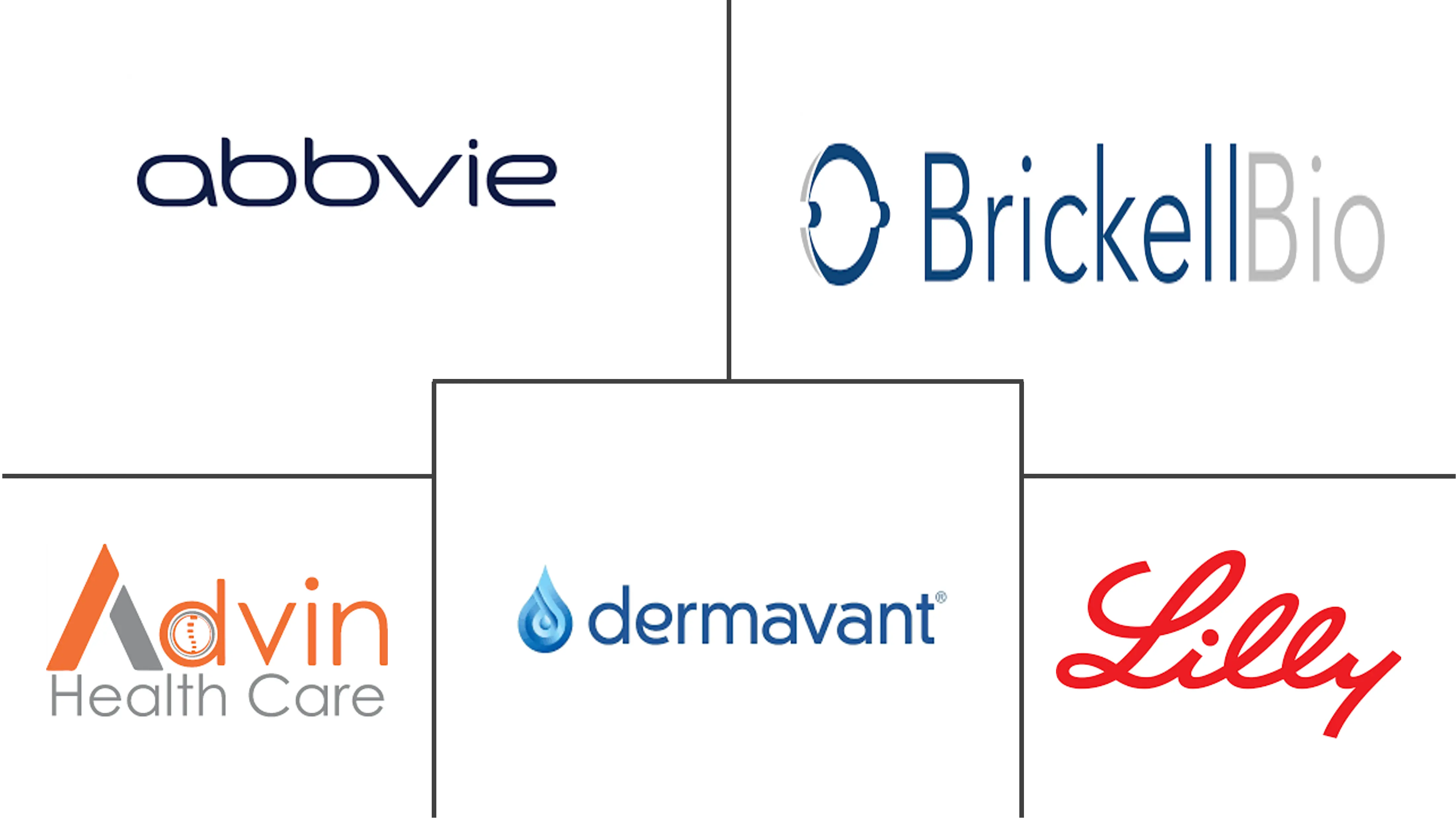Market Size of Hyperhidrosis Treatment Industry

| Study Period | 2019 - 2029 |
| Market Size (2024) | USD 656.72 Million |
| Market Size (2029) | USD 860.76 Million |
| CAGR (2024 - 2029) | 5.56 % |
| Fastest Growing Market | Asia-Pacific |
| Largest Market | North America |
Major Players
*Disclaimer: Major Players sorted in no particular order |
Hyperhidrosis Treatment Market Analysis
The Hyperhidrosis Treatment Market size is estimated at USD 656.72 million in 2024, and is expected to reach USD 860.76 million by 2029, growing at a CAGR of 5.56% during the forecast period (2024-2029).
The pandemic has significantly impacted the market. For instance, as per the NCBI study published in January 2021, during the initial phase of the COVID-19 infection, the condition of most of the prolonged cases of hypothermia resulted in fever. Thus, the demand for hyperhidrosis treatment increased initially; however, the market also witnessed an adverse impact. According to the International Hyperhidrosis Society in May 2021, sweat could help prevent the transmission of COVID-19. The organization supports that claim with quotes from experts like dermatologist Adam Friedman of George Washington University, who noted that "Sweat has some inherent antimicrobial activity." Therefore, the market witnessed moderate growth during the initial days of the pandemic. However, with the declining cases of COVID-19, the market has started to gain momentum and is expected to witness an upward trend over the forecast period.
The key factors bolstering the growth of the hyperhidrosis treatment market are the rise in the prevalence of secondary hyperhidrosis conditions and the increase in investments in research and development by the market players. According to the NCBI study published in October 2021, in the United States, the prevalence rate of this disorder was estimated to be around 3.0% of the total population. Emotional, psychological, social, and occupational impairment can all be caused by hyperhidrosis.
Some other factors that could potentially impact the market's growth are the promising pipeline for hyperhidrosis treatment, the growing prevalence of depression and anxiety, growing awareness about hyperhidrosis, and the presence of favorable reimbursement policies. For instance, in October 2021, Brickell Biotech Inc. reported positive topline results from the Phase 3 pivotal Cardigan I and Cardigan II studies, which evaluated sofpironium bromide gel, 15% as a once-daily topical formulation in patients with primary axillary hyperhidrosis. Thus, the increasing burden of hyperhidrosis and treatment advancements are anticipated to bolster the demand for its treatment, thereby boosting the market's growth.
Geographical expansions, product launches, acquisitions, collaborations, mergers, and partnerships by major players to establish a strong presence positively impact the market. For instance, in April 2021, Fortress Biotech, the partner company of Journey Medicals, entered into a definitive agreement to acquire Qbrexza (glycopyrronium) in the United States from Dermira, a wholly-owned subsidiary of Eli Lilly. Thus, owing to these factors, the market studied is expected to witness growth over the forecast period.
However, short-term results of cosmetic and therapeutic procedures are likely to restrain the growth of the hyperhidrosis treatment market over the forecast period.
Hyperhidrosis Treatment Industry Segmentation
Hyperhidrosis is a disorder where the patient experiences excessive sweating issues that are independent of environmental conditions and thermoregulatory requirements.
The hyperhidrosis treatment market is segmented by disease type (primary focal hyperhidrosis and secondary generalized hyperhidrosis), treatment type (topical treatments, disposable, surgical treatments, botulin toxin A, iontophoresis, laser treatments, and other treatment types), and geography (North America, Europe, Asia-Pacific, Middle East and Africa, and South America). The report also covers the estimated market sizes and trends for 17 countries across major regions globally. The report offers value (in USD million) for the above segments.
| By Treatment Type | |
| Topical Treatments | |
| Surgical Treatments | |
| Botulin toxin A | |
| Iontophoresis | |
| Laser Treatments | |
| Other Treatment Types |
| By Disease Type | |
| Primary Focal Hyperhidrosis | |
| Secondary Generalized Hyperhidrosis |
| Geography | ||||||||
| ||||||||
| ||||||||
| ||||||||
| ||||||||
|
Hyperhidrosis Treatment Market Size Summary
The hyperhidrosis treatment market is poised for growth, driven by an increasing prevalence of secondary hyperhidrosis conditions and heightened investments in research and development by key market players. The market experienced initial fluctuations due to the COVID-19 pandemic, which temporarily boosted demand but also posed challenges. As the pandemic's impact wanes, the market is regaining momentum, supported by advancements in treatment options and growing awareness of hyperhidrosis. Factors such as favorable reimbursement policies and promising treatment pipelines, including the development of new topical formulations, are expected to further propel market growth. Geographical expansions and strategic partnerships among major players are also contributing to the market's positive outlook.
North America is anticipated to lead the hyperhidrosis treatment market, driven by a high prevalence of the condition and the presence of major market players. The region's growth is supported by technological advancements and an increasing adoption of various treatment options. The market is characterized by moderate competition, with prominent players like AbbVie, Brickell Biotech, and Eli Lilly actively investing in research and development to strengthen their product pipelines. The effectiveness of treatments such as botulinum toxin type A, known for its long-lasting effects and high patient satisfaction, is a significant driver of market expansion. Despite the competitive landscape, the market is expected to witness considerable growth, fueled by ongoing innovations and strategic collaborations.
Hyperhidrosis Treatment Market Size - Table of Contents
-
1. MARKET DYNAMICS
-
1.1 Market Overview
-
1.2 Market Drivers
-
1.2.1 Rise in Prevalence of Secondary Hyperhidrosis Condition
-
1.2.2 Increase in Investments by Market Players in Research and Development
-
-
1.3 Market Restraints
-
1.3.1 Short-term Results of Cosmetic and Therapeutic Procedures
-
-
1.4 Porter's Five Forces Analysis
-
1.4.1 Threat of New Entrants
-
1.4.2 Bargaining Power of Buyers/Consumers
-
1.4.3 Bargaining Power of Suppliers
-
1.4.4 Threat of Substitute Products
-
1.4.5 Intensity of Competitive Rivalry
-
-
-
2. MARKET SEGMENTATION (Market Size by Value - USD million)
-
2.1 By Treatment Type
-
2.1.1 Topical Treatments
-
2.1.2 Surgical Treatments
-
2.1.3 Botulin toxin A
-
2.1.4 Iontophoresis
-
2.1.5 Laser Treatments
-
2.1.6 Other Treatment Types
-
-
2.2 By Disease Type
-
2.2.1 Primary Focal Hyperhidrosis
-
2.2.2 Secondary Generalized Hyperhidrosis
-
-
2.3 Geography
-
2.3.1 North America
-
2.3.1.1 United States
-
2.3.1.2 Canada
-
2.3.1.3 Mexico
-
-
2.3.2 Europe
-
2.3.2.1 Germany
-
2.3.2.2 United Kingdom
-
2.3.2.3 France
-
2.3.2.4 Italy
-
2.3.2.5 Spain
-
2.3.2.6 Rest of Europe
-
-
2.3.3 Asia-Pacific
-
2.3.3.1 China
-
2.3.3.2 Japan
-
2.3.3.3 India
-
2.3.3.4 Australia
-
2.3.3.5 South Korea
-
2.3.3.6 Rest of Asia-Pacific
-
-
2.3.4 Middle East and Africa
-
2.3.4.1 GCC
-
2.3.4.2 South Africa
-
2.3.4.3 Rest of Middle East and Africa
-
-
2.3.5 South America
-
2.3.5.1 Brazil
-
2.3.5.2 Argentina
-
2.3.5.3 Rest of South America
-
-
-
Hyperhidrosis Treatment Market Size FAQs
How big is the Hyperhidrosis Treatment Market?
The Hyperhidrosis Treatment Market size is expected to reach USD 656.72 million in 2024 and grow at a CAGR of 5.56% to reach USD 860.76 million by 2029.
What is the current Hyperhidrosis Treatment Market size?
In 2024, the Hyperhidrosis Treatment Market size is expected to reach USD 656.72 million.

